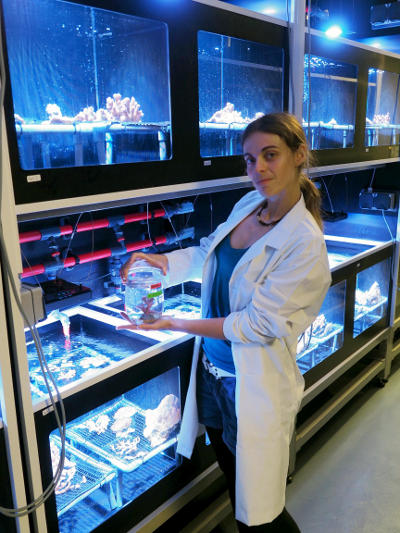Using AI to control energy for indoor agriculture
30 September 2024
Published online 7 June 2017
Scientists use sugar to expose the role of pollutants in coral bleaching events.

© Nils Raedecker
The underlying mechanisms of bleaching events are not fully understood. While marine biologists agree that rising water temperatures constitute one of the most significant threats to corals by undermining the delicate symbiosis between the microscopic algae and the coral skeleton, they suspect other factors may be involved.
Recent studies have suggested that excess nitrogen may damage the algae's cell membrane, causing them to become increasingly sensitive to heat.
To unravel the ties between bleaching and microbial nitrogen fixation, the researchers at King Abdullah University of Science and Technology (KAUST) in Thuwal, Saudi Arabia and the Leibniz Center for Tropical Marine Ecology in Bremen, Germany, conducted an experiment in KAUST’s Red Sea coast laboratory where they fed corals doses of labile dissolved organic carbon, which contains sugar.
Large quantities of sugars are found in wastewater, agricultural runoffs and other sources of anthropogenic pollution.
Christian Voolstra, co-author of the Global Change Biology study1 and KAUST marine biologist, explains that many nitrogen fixers consume sugars and use them as an energy source. Therefore, hosting nitrogen-fixing microbes is beneficial to the coral; it provides the corals and their algae with much-needed nitrogen for metabolism and growth. “However, too much nitrogen from untreated wastewater or agricultural runoffs can harm the coral meta-organism,” explains Voolstra.
“By understanding why other environmental factors also induce coral bleaching, we can identify previously overlooked processes that may explain what happens during coral bleaching caused by heat stress,” explains Voolstra. While a small amount of nitrogen helps the coral, an excess can disturb the delicate nutrient equilibrium within the coral, making the algal symbionts more sensitive to high temperature stress, leading to bleaching.
Ameer Abdulla, a senior research fellow at the Center of Biodiversity and Conservation Sciences and at the Global Change Institute, University of Queensland, Australia, says the study results may help explain distribution patterns in bleaching events that have increased in frequency, intensity, and scale around the world.
Abdulla, who was not involved in the study, adds that while climate change mitigation efforts are still needed to prevent future coral bleaching events, this study shows that pollution, especially untreated wastewater discharges, can harm corals directly and indirectly.
On the west coast of Saudi Arabia, for instance, specifically around Jeddah, high nutrient and sugar levels have been reported. “Since nutrients and sugars inputs do rapid and wide-scale damage to corals, these harmful impacts could be minimized by improving wastewater and sewage treatment facilities,” says Voolstra.
Abdulla believes that research like this is enough to make adequate and urgent conservation and management decisions. “Waiting for more research on coral bleaching mechanisms before making critical management decisions will surely seal the demise of coral reefs around the world,” he says.
doi:10.1038/nmiddleeast.2017.101
Stay connected: